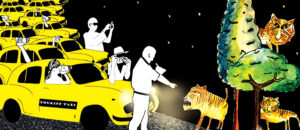Only a minuscule number of people residing near tourist attractions find work in the industry. And most of those who do get low-paid jobs
On World Tourism Day, the United Nations World Tourism Organisation assigned India the theme of “Tourism & Jobs: A better future for all”. In keeping with the theme, many plenaries and workshops were conducted across India, echoing the dictum that tourism brings in jobs. Tourism does indeed create jobs: according to the World Travel and Tourism Council, India’s tourism sector generated over 42.6 million jobs in 2018 and contributed 9.2 per cent of the Gross Domestic Product.
Such numbers, impressive as they are, however, do not capture how tourism affects the local communities, for better or for worse. They don’t show what kind of jobs tourism generates, what are the living conditions of the workers in the tourism industry, or whether tourist activity benefits the communities most affected by it.
It is often said that tiger tourism, for one, has brought jobs and development to the communities living around tiger reserves. That is quite far from being the reality. The creation of protected areas for tiger tourism continues to displace and marginalise the Adivasis. Where they find work in the industry, it’s usually low-paid: they’re employed as security guards, gardeners, waiters, and, if they get lucky, as guides and drivers. Managerial jobs are filled mostly by “outsiders”.
A 2010 study covering 10 protected areas across India, including Sariska, Bandipur, Ran-thambore, Nagarhole, Kanha, and Pench, revealed that, on average, a minuscule 0.001 per cent of the people living within a 10-km radius of these areas benefited directly from tourism-related employment. And most of those who did were hired for low-paid positions such as gardening or housekeeping.
Another study, conducted in 2012 in Madhya Pradesh’s Kanha National Park, found that only 19% of the population in the seven villages surveyed were involved in tourism-related activities. The Adivasis of Gond and Baiga communities, in particular, only found work as guides, drivers and guards at the resorts in and around the park. Of the resorts surveyed, 84% were owned by people from metropolitan cities far away.
Workers without rights
Another major aspect that the job numbers tend to obscure is the working conditions and the rights of those employed in the Indian tourism industry.
A 2011 study of a few national and international hotel chains in Goa found that half their employees were on fixed-term contracts or engaged through contract agencies. Contractualisation enables employers to hire and fire at will since they are not bound by the labour laws that safeguard the rights of permanent staffers. In the case of Goa’s hotel workers, the study found, this led to anxiety as they didn’t know when they might be put out of work. So, they often put in long intensive hours in the hope that their services would be regularised.
It’s a similar story in Bodh Gaya, a major religious tourism destination, where the local people, predominantly from the Scheduled Castes, have found work mainly as security guards, gardeners, cooks, and servants. Theirs is insecure employment and they are deprived of labour rights such as paid leave, fixed work hours, pension and insurance benefits. They earn ₹5,000-8,000 a month which is barely enough for sustenance.
India’s tourism industry is also beset by the problem of child labour. A study conducted in Goa in 2016 found that children from Karnataka, West Bengal, Odisha, even Nepal were, without adult supervision, selling trinkets; performing acrobatics and circus tricks; working on beaches and in shops, roadside eateries, restaurants, hotels. They belonged mostly to Scheduled Castes and Scheduled Tribes, and lived in extreme poverty, making them vulnerable to physical, economic and emotional exploitation by strangers, and, often, easy prey for travelling child sex offenders.
Condition of street vendors
The presence of street vendors near tourist attractions is often projected as proof of job creation, while their working conditions and labour rights are overlooked. A 2012 study of women street vendors in Bodh Gaya, Puri, Bhubaneshwar, and Goa found that most of them lived precarious lives. They were fully dependent on footfall for hand-to-mouth existence, with many earning no more than ₹20 per day and forever facing the threat of eviction.
In Bodh Gaya, the street vendors have no say in how tourism is envisioned. Depending on their socioeconomic status, they earn anywhere between ₹200-300 and ₹1,000-1,500 rupees a day. For many of them, street vending is the sole source of livelihood, especially the Scheduled Caste Manjhis. The vendors are forced to shut shop every time a VIP visits Bodh Gaya as if they are a nuisance. Similarly, on the pretext of implementing the master plan of Bodh Gaya, which envisions a clean and serene space around the Mahabodhi temple, the vendors keep getting pushed further out to the periphery year by year. Vending complexes created by the government lie empty since they are 2-3 km from the Mahabodhi temple, far away from the sight of any tourist.

In fact, at most tourist places in India, the implementation of the Street Vendors Protection of Livelihood and Regulation of Street Vending Act, 2014, which lays out a process for surveying street vendors and establishing vending zones, and ensuring the protection of street vendors from arbitrary evictions, is next to minimal.
The precarity of Bodh Gaya’s street vendors, the displacement of Adivasi communities from tiger reserves, the insecurity of workers in Goa’s tourism industry, and the prevalence of child labour underscore how the generally celebratory talk around job numbers provided by the government and the industry often obscure the lived realities of the communities most affected by tourism.
It’s time we worked towards developing a tourism industry that is just, equitable, and democratic, and that helps ensure a better future for all.
www.newslaundry.com





